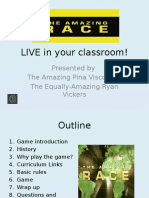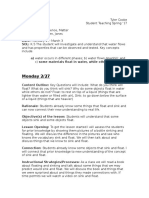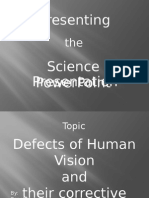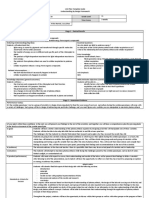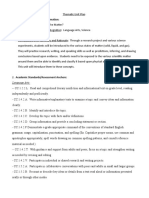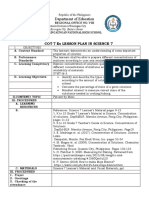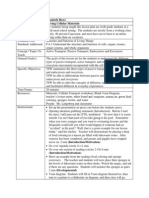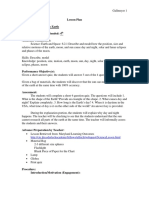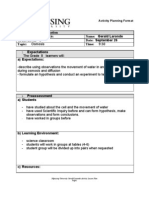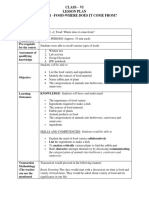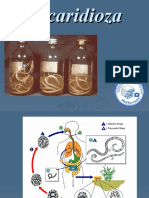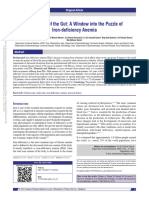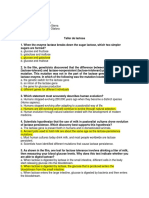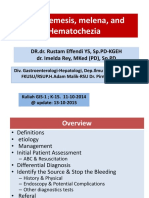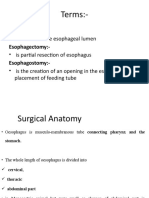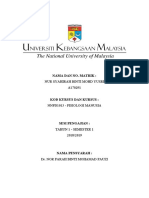0 ratings0% found this document useful (0 votes)
702 viewsUnit Plan Science - Digestive and Excretory Systems
Unit Plan Science - Digestive and Excretory Systems
Uploaded by
api-256746237Copyright:
© All Rights Reserved
Available Formats
Download as PDF, TXT or read online from Scribd
Unit Plan Science - Digestive and Excretory Systems
Unit Plan Science - Digestive and Excretory Systems
Uploaded by
api-2567462370 ratings0% found this document useful (0 votes)
702 views51 pagesOriginal Title
unit plan science - digestive and excretory systems
Copyright
© © All Rights Reserved
Available Formats
PDF, TXT or read online from Scribd
Share this document
Did you find this document useful?
Is this content inappropriate?
Copyright:
© All Rights Reserved
Available Formats
Download as PDF, TXT or read online from Scribd
Download as pdf or txt
0 ratings0% found this document useful (0 votes)
702 views51 pagesUnit Plan Science - Digestive and Excretory Systems
Unit Plan Science - Digestive and Excretory Systems
Uploaded by
api-256746237Copyright:
© All Rights Reserved
Available Formats
Download as PDF, TXT or read online from Scribd
Download as pdf or txt
You are on page 1of 51
J udith-Hope Bates, J ustin Groeneveld, Mrs.
Laurie Ruhstorfer, & Chris Webb
April 20, 2007
Unit Plan: Digestive and Excretory Systems
Subject/Topic:
This Instructional Unit is designed to teach the digestive and excretory systems to fourth and/or
fifth graders. The unit teaches subject matter which is foreign to most students in this age group and
therefore will start with a broad introduction and then will be broken down into individual sections of
both systems for more detailed instruction. The individual lesson plans include the mouth, esophagus
and stomach, small intestine and gall bladder, large intestines and rectum, and the excretory system as a
whole. This unit is planned for eight days with a lesson planned for 1-1 hours each of those days.
Rationale/Purpose:
The digestive and excretory systems are invaluable to life and therefore are absolutely necessary
to ones education. One has to eat and drink to stay alive and the digestive and excretory systems are
what do the eating, drinking, and processing of nutrients essential to life. When the students go through
this unit they will learn about how their body processes food and water and gets nutrients out of it. The
underlying messages in this unit are healthy lifestyle choices when it comes to selecting the foods to eat.
Obesity is one of the Nations largest concerns for its children and making healthy food choices is one
way to help cut down on child obesity. This unit embraces the hands-on approach to teaching and also
helps impact the students beyond the classroom. It also offers plenty of opportunities for character and
responsibility lessons while working in groups, doing experiments with chemicals, and learning about
the benefits of healthy foods.
Note: This unit is required by the Michigan Curriculum Framework Benchmarks, but NOT by
the Michigan Model, thus most of the students do not learn this material until they get to junior high or
high school.
Unit Map/Plan:
Goals:
In alignment with Michigan Framework standards, this unit seeks to:
Explain how selected systems and processes work together in animals.
MI.LO.III.2.M.4
In alignment with Kent County Collaborative Core Curriculum, this unit seeks to:
Analyze the structure and functions of the human digestive and excretory systems tracing the
flow of food and elimination of wastes through the body.
KC4 4:3
By the end of this unit, students should
be able to identify the major organs in the digestive and excretory systems.
be able to recognize the value of the digestive and excretory system in their daily survival of life.
be able to differentiate between the digestive and excretory systems.
The lessons are placed in the order they are because first, we wanted to introduce the students to
the overall function of digestive system in the first four lessons. Then in the second group of four
lessons we introduced the excretory system. This follows the digestive systems process, in the body.
The topic of the lessons are based on the order that organs and body parts are used, to break down foods
and liquids, in the digestive and excretory systems, starting in the mouth.
Bates, Groeneveld, Ruhstorfer, & Webb
2
Lesson One: Introduction to the Digestive and Excretory Systems
Students will understand the digestive system in a big picture sense.
Students will be able to describe the functions of the major organs involved in the digestive process.
Students will describe the digestive process through a journal entry.
Lesson Two: The Mouth
Students will locate and describe all of the essential parts of the mouth and write a brief description
of what each part does in the process.
Students will compare and contrast different functions of the teeth, tongue, and salvia.
Lesson Three: Esophagus and Stomach
Students will be shown a three dimensional stomach and a picture of the esophagus and they will
generate a list of questions concerning these objects and answer them during direct instruction and
group work.
Students will draw a picture of the human body and label the stomach, esophagus, small intestine
and mouth and show how they relate.
Students will specify how key words relate to the esophagus and stomach by writing a short essay or
adding them to their drawing and writing a few words about what the thing does.
Lesson Four: Small Intestines, Gall Bladder, Pancreas, and Liver
Students will identify the organs involved in this stage of the digestive system {small intestine, liver,
gall bladder, & pancreas} through a model or diagram.
Students will describe how food continues to digest in this stage (small intestine) of the Digestive
System.
Students will classify foods according to the chemicals that break them down.
Students will relate that chemicals are present in the human body and also break down food into
usable nutrients.
Lesson Five:
Students will understand what the large intestine is and its functions.
Students will be able to describe the functions of the large intestine.
Students will be able to name the parts of the large intestine accurately.
Lesson Six: The Human Excretory System
Students will recall all of the names of the various organs within the excretory system
Students will compose their own model of the excretory system
Students will identify the structures of the excretory system through a model
Students will compose their own model of the excretory system
Lesson Seven: Digestive System: Real Application
Students will locate and label all of the essential parts of the digestive system and write a brief
description of what each part does in the process.
Students will compare and contrast different foods as they travel through the body system.
Bates, Groeneveld, Ruhstorfer, & Webb
3
Lesson Eight: Assessment of Digestive and Excretory Systems
Students will draw the pathway of a piece of food as it goes through the digestive and excretory
system.
Students will draw the pathway of liquid as it goes through the digestive and excretory system.
Students will distinguish the main organs in the digestive and excretory system and how long the
food/liquid stays in each organ.
Bates, Groeneveld, Ruhstorfer, & Webb
4
Bates, Groeneveld, Ruhstorfer, & Webb
5
Outline of Daily Lesson Plans:
Day 1: Introduction to the Digestive System
Day 2: The Mouth and Eating
Day 3: The Esophagus and the Stomach
Day 4: Small Intestines, Liver, Gall Bladder & the Pancreas
Day 5: Large Intestines, Colon, Rectum
Day 6: Excretory System
Day 7: Real Life Application How our Body Reacts to Foods
Day 8: Assessment of the Digestive and Excretory Systems
Instructional strategies and materials: (see attached individual lesson plans)
Assessment Strategies:
Assessment of overall unit will be done based on a formative assessment. This will be done
through a test that covers all of our goals in the unit. There will be multiple choice, matching, and short
essay questions on the test.
Lesson One: Introduction
1. Students will write in their journals how their M&Ms traveled through the digestive system
expressing knowledge of each part of the system.
a. The students will label the organs in order in their journals.
b. The students will tell the function of each of the organs involved in the process in
their journals.
Lesson Two: Mouth
2. Students will locate and describe all of the essential parts of the mouth and write a brief
description of what each part does in the process.
a. Students will be given a piece of paper with the tongue, teeth, and salivary glands on
it. They will be asked to discuss the importance of this part with their neighbor. The
teacher will walk around the room, noticing the conversations that are going on. This
will not be weighted very high and will be graded on participation alone
b. The student may create some type of visual representation of the mouth in some form
such as power point, poster board, or 3-D representation. This assessment will be
done in groups of 3 and will be weighted rather high. The students must include a
description of each part and what its purpose is in the process of digestion. The
project will be graded on creativity and informational accuracy.
3. Students will compare and contrast different functions of the teeth, tongue, and salvia.
a. The students will create a chart that to compare and contrast the different parts of the
mouth. They can compare just two or all three if they want. They may create any
type of chart they wish such as a vinn-diagram, columns, or other method of
organizing. This will be done individually and will be worth a moderate weight. The
grading criteria will be based on number of comparison/contrasts made between the
parts and the accuracy of their comparisons. Extra points will be added to those who
try to do all three.
Bates, Groeneveld, Ruhstorfer, & Webb
6
b. The students will discuss with a partner about the similarities and differences between
each type of tooth. This will be assessed by participation with the activity. The
activity will not be very highly weighted.
Lesson Three: Esophagus and Stomach
1. Students will be shown a three dimensional stomach and a picture of the esophagus and they
will generate a list of questions concerning these objects and answer them during direct
instruction and group work.
a. This will be graded on participation in the generation of questions and their relation to
the topic. This will not be weighted heavily.
2. Students will draw a picture of the human body and label the stomach, esophagus, small
intestine and mouth and show how they relate.
a. Students will hand in the picture they draw and will be assessed on the accuracy of
their labeling. This will be a moderate weight for grading
b. They will discus with their partner about how these parts relate with one another and
how they work together. This will be graded by participation in the activity and will
be weighted light.
3. Students will specify how key words relate to the esophagus and stomach by writing a short
essay or adding them to their drawing and writing a few words about what the thing does.
a. This will be assessed through the strength of interaction between the key words. The
grades will be based on the short essay and the accuracy of the information. This will
be a highly weighted grade.
b. The students will add the key words to the drawing and write about it does. This will
be graded by the accuracy of the information on the drawing and will be handed in.
This will be a moderately weighted grade.
Lesson Four: Small Intestine
1. Students will identify the organs involved in this stage of the digestive system {small
intestine, liver, gall bladder, & pancreas} through a model or diagram.
AND
2. Students will learn how food continues to digest in this stage (small intestine) of the
Digestive System.
a. This can be assessed through a worksheet and label each of these organs on the
worksheet. This work sheet will be handed in and graded for content accuracy and
will be moderately weighted.
b. The students will look at a 3-D model of the human organs and, as a class, the
students will say the name of the organ as the instructor points to each one. This will
be assessed as a participation grade and will be lightly weighted
3. Students will classify foods according to the chemicals that break them down.
AND
4. Students will relate that chemicals are present in the human body and also break down
food into usable nutrients.
a. The students will write down there observations on paper and will orally interact with
the instructor about their responses. The instructor will affirm correct answers. This
assessment will be based on participation and will be moderately weighted.
Lesson Five: Large Intestine
1. The students will write a paper using vocabulary terms specified in the lesson plan.
Bates, Groeneveld, Ruhstorfer, & Webb
7
2. Within the paper the students will describe the path that food travels within the Large
Intestine.
3. Within the paper the students will also accurately use the vocabulary terms.
Lesson Six: Excretory System
1. Students will recall all of the names of the various organs within the excretory system
a. The students will be given a worksheet with the organs of the excretory system. The
will be asked to label each of the organs correctly. This will be handed in and
assessed through the accuracy of their labeling. This will be a highly weighted
activity
2. Students will compose their own model of the excretory system
AND
3. Students will identify the structures of the excretory system through a model
a. The students will create a model of the excretory system and interact with it with their
partners. They must use the correct labels when explaining it to their partners. The
instructor will rotate around the room listening to individual students answers. This
will be assessed by the instructors observations of the appropriate use of labels and
accuracy of the information shared. This will be a moderately weighted assignment
Lesson Seven: Real Life Application
1. Students will locate and label all of the essential parts of the digestive system and write a
brief description of what each part does in the process.
a. The students will receive a worksheet with all of the parts of the digestive system and
will be asked to label each part. They will share their share what the function of each
organ is in the system with a partner. This will be graded based on the accuracy of
the labeling (highly weighted) as well as participation in the sharing of the functions
with their partner (moderately weighted).
2. Students will compare and contrast different foods as they travel through the body system.
a. Students will write a story telling of the process that two different foods take through
the digestive system. They must use appropriate terms that were discussed in class in
relation to the system. This will be highly weighted and will be assessed by accuracy
of information and depth of comparison between the two foods travels.
Lesson Eight: Review
1. Students will draw the pathway of a piece of food as it goes through the digestive and
excretory system.
AND
2. Students will draw the pathway of liquid as it goes through the digestive and excretory
system.
a. Students will be given a worksheet with the appropriate organs and will trace the
pathways of food in one color and liquid with a different color. This will be assessed
through the accuracy of the pathways.
3. Students will distinguish the main organs in the digestive and excretory system and how long
the food/liquid stays in each organ.
a. The students will be given a worksheet that has each part of the digestive and
excretory system. The students will fill in how long food is in each of the parts of the
system. This will be weighted low and will be based on participation
Bates, Groeneveld, Ruhstorfer, & Webb
8
These assessments will measure both the students, through their interaction with information as
well as the instructors lesson, through how well the students interact with the assessments. If the
students struggle with the assessments, this is a reflection on the instructors organization of the unit.
Areas that need to be adjusted and refined can be pinpointed based on students understanding of the
material.
Individual Lesson Plans: (see attached Lesson Plans on the following pages)
Bates, Groeneveld, Ruhstorfer, & Webb
9
Lesson 1: Introduction to the Digestive System
Title:
Everyone Poops
Subject/Grade Level:
Digestive System/4
th
& 5
th
Grade
Rationale/Purpose:
Students should know this material because it happens in their bodies.
Its value is that the students will have a better understanding of what is happening in their bodies
when they eat food and then poop it out.
Objectives:
The learner will understand the digestive system in a big picture sense.
The learner will be able to describe the functions of the major organs involved in the digestive
process.
The learner will describe the digestive process through a journal entry.
Content:
The teacher has to know a college level definition of the digestive system, the organs involved, and
why the body needs the digestive system to function properly.
The concepts that should be taught are:
a. Food has to go though a process to be broken down.
b. Food doesnt just go to the stomach and out the anus.
c. The digestive system is an essential part of living.
Materials:
Large, thin plastic bag
Newspaper
Paper bags
Zip-loc bags
M&Ms candy
Sponges
Labeled spray bottles of water
Trash Can
Everyone Poops by Taro Gomi
Strategies and Activities:
Engage:
Read Everyone Poops by Taro Gomi to the class. Ask students to give some opinions on
how the body works to digest and get rid of food and write them on the board.
Bates, Groeneveld, Ruhstorfer, & Webb
10
Explore:
Put the students into groups of four. Give the students the cut out parts of the digestive
system (which are all labeled) and have them organize them in what order they think it
should go and talk about it together in their groups. They should explain why they think
something goes where they put it each time they make a suggestion.
Explain:
When the activity is done, ask the students to explain what path they think food goes as it
passes through the body. Have every group share what order they put things in and why
they put it that way. Tape up on the board the correct path and briefly go over how and
why it works that way and what purpose each part serves for digestion.
Elaborate:
Explain the activity of demonstrating a life size digestive process. Have students line up
in two single file lines directly across from one another and give them their labeled
names from the digestive tract (i.e. teeth, salivary glands, esophagus, etc.). Next, hand
them the food (the plastic bags filled with the paper and bags and M&Ms) and have
them break it apart as it goes through the digestive tract of students. As they go through
the processes of each ones duty, they will share what they are doing (i.e. salivary
glands spraying food with water bottles and saying, I am a salivary gland and I am
breaking down the food with my enzymes) with the class.
Evaluate:
At the end of the lesson the students will be given some M&Ms to eat. As they eat the
M&Ms they will be asked to journal what the M&Ms are doing in their digestive
system and explain where it goes next and what happens there. They will be given some
time at the end of the class to journal as much as they can recall and turn it in at the end
of the time.
Bates, Groeneveld, Ruhstorfer, & Webb
11
Lesson 2: The Digestive System: The Mouth
Subject/Grade Level:
This lesson will introduce the students to the mouth and all of the digestive components
contained in the mouth including the tongue, teeth, and saliva
Grade 4
th
/5
th
Rationale/Purpose:
The mouth is the first stage of the digestive system and begins the digestive process. The
student will need to understand this stage in order to have an accurate understanding of
following stages in the system.
The students will have a clear understanding of what the mouth does to food and how to take
care of it.
KC4 4:3 A TLW identify and label parts of the digestive system
KC4 4:3 C TLW explain the functions of organs involved in the process of digestion and
the order of the digestion
Objectives:
TLW locate and describe all of the essential parts of the mouth and write a brief description
of what each part does in the process
TLW compare and contrast different functions of the teeth, tongue, and salvia
Content:
The teacher should have a deep understanding of how the components of the mouth are
involved with digestion.
The teacher should have a deep understanding of where salvia comes from and what it
contains that helps break down food.
The concepts being taught
The function of the teeth and tongue in the digestive process
The significance of salvia in the early stages of digestion
Materials:
Food (enough for whole class)
Saltine crackers
J elly Beans
Grape
Plastic bag to hand food out in
slice of cheese
Paper
Pencil
Strategies and Activities:
Engage Explain to the students that we are going to have a feast today. We are going to get
to eat some food and have some drink. Learning about the digestive system doesnt have to
be sitting and listening but can be fun and taste good too.
Explore The students will be put into groups of two and will each be given a grape, a
saltine cracker, a jelly bean, and a bottle of water. Each student will take one food at a time
Bates, Groeneveld, Ruhstorfer, & Webb
12
and put it in his or her mouth. After each food is consumed the students will discuss what
was going on inside of their mouths. They will take note of things such as flavors,
consistence of food immediately and just prior to swallowing, and how long the food must
stay in the mouth before being able to swallow. They will write down some of the key
observations that they noticed with each food they consumed. Why did some foods take
longer to swallow than others? What was the tongue doing or the teeth doing for each food?
Were they doing different things for different foods? Once they have completed the
questions about the food, I will ask them to take out their slices of cheese and bite down on
them. It is important that they do not bite all the way through the cheese slice. I will ask
them to hypothesize about why our teeth are shaped differently and what each type of tooth is
meant for.
Explain When the students are completed with their comparisons between the different
foods, we will come back together as a whole class to share some of our observations. I will
put a column on the board for each food that was consumed during the explore section. I will
ask around the room for students to each contribute one of their observations until all of the
columns are equally full. I may point out any variances in answers and ask for student input
on why there maybe differences in the responses. From this discussion, I will begin to
introduce some of the technical terms and the function of the tongue and teeth. I will talk
about taste buds, moving food around in the mouth, and testing the food for appropriate
temperature and texture. I will introduce the uvula and its function as well as the different
salvia glands including the parotid, sublingual, and submandibular salivary glands. I will
also point out the difference between mechanical and chemical digestion. This will lead into
a discussion of what happens to your teeth if they get plaque on them and the importance of
keeping your teeth brushed, flossed, and plaque free.
Elaborate The students will have the opportunity to choose one of the foods, not including
cheese, and once again eat their choice of food. They will closely pay attention to what is
going on in their mouth during its initiation of digestion including the tastes and textures that
are felt. The student will write a story about the food while it is in the mouth and they must
include some of the terms we talked about in class. They may want to add the removal of
plaque or left over food particles at the end of their story.
Evaluation I will use the papers describing the activity in the mouth as my evaluation of the
students understanding of the material. This also includes some writing within the activity
and should be a good assessment for the lesson.
Plans for Individual Differences:
Dyslexic Partner will be able to assist the student in reading the material out loud to him.
This will help the dyslexic not feel rushed or behind because of his inability to read as
quickly as others.
It is inevitable that someone will not like some of the food options for this task. So, the
reason they are working in groups of two is to avoid a student missing out on an item by
allowing only his partner to try the food and explain what he feels.
Bates, Groeneveld, Ruhstorfer, & Webb
13
Worksheet 1: Food Flavors, Textures, and What Happens?
Food #1
What type of food is it? ______________________________________________________________
What are some of the Flavors that you taste?
____________________________________________________________________________________
Does the consistency and/or texture of the food change as you break it down in your mouth? If
so, what are some of the changes you notice?
____________________________________________________________________________________
____________________________________________________________________________________
How long did you need to chew the food in your mouth before you swallowed it?
____________________________________________________________________________________
____________________________________________________________________________________
Food #2
What type of food is it? ______________________________________________________________
What are some of the Flavors that you taste?
____________________________________________________________________________________
____________________________________________________________________________________
Does the consistency and/or texture of the food change as you break it down in your mouth? If
so, what are some of the changes you notice?
____________________________________________________________________________________
____________________________________________________________________________________
How long did you need to chew the food in your mouth before you swallowed it?
____________________________________________________________________________________
____________________________________________________________________________________
Bates, Groeneveld, Ruhstorfer, & Webb
14
Worksheet 1: Food Flavors, Textures, and What Happens?
Continued
Food #3
What type of food is it? ______________________________________________________________
What are some of the Flavors that you taste?
____________________________________________________________________________________
____________________________________________________________________________________
Does the consistency and/or texture of the food change as you break it down in your mouth? If
so, what are some of the changes you notice?
____________________________________________________________________________________
____________________________________________________________________________________
How long did you need to chew the food in your mouth before you swallowed it?
____________________________________________________________________________________
____________________________________________________________________________________
ANALAYSIS QUESTIONS
Directions: Talk with your partner about the questions below. Try to decide what some
of the differences are between each food as it is broken down in the mouth as well as
some of the similarities.
1. Why did some of the foods take longer to swallow than other foods?
2. Explain what the tongue was doing for each food?
3. Which teeth were doing most of the chewing?
4. What might be the purpose of the other teeth?
5. Are the actions of the tongue and/or teeth different when chewing each
different food? If so, how?
Bates, Groeneveld, Ruhstorfer, & Webb
15
The mouth contains the
tongue, salivary
glands, and teeth. The
salivary glands secrete
saliva into our mouth
to lubricate food and
begin to break food
into bolus.
Name ______________________________________________________________________________
Worksheet 2: What is in Your Mouth that Aides Digestion?
The mouth contains 3
major types of teeth,
incisors, canines, and
molars. These teeth
serve different
purposes in breaking
down food such as
cutting, tearing, and
grinding.
Bates, Groeneveld, Ruhstorfer, & Webb
16
Assessments:
4. Students will locate and describe all of the essential parts of the mouth and write a brief
description of what each part does in the process.
a. Students will be given a piece of paper with the tongue, teeth, and salivary glands on
it. They will be asked to discuss the importance of this part with their neighbor. The
teacher will walk around the room, noticing the conversations that are going on. This
will not be weighted very high and will be graded on participation alone
b. The student may create some type of visual representation of the mouth in some form
such as power point, poster board, or 3-D representation. This assessment will be
done in groups of 3 and will be weighted rather high. The students must include a
description of each part and what its purpose is in the process of digestion. The
project will be graded on creativity and informational accuracy.
5. Students will compare and contrast different functions of the teeth, tongue, and salvia.
a. The students will create a chart that to compare and contrast the different parts of the
mouth. They can compare just two or all three if they want. They may create any
type of chart they wish such as a vinn-diagram, columns, or other method of
organizing. This will be done individually and will be worth a moderate weight. The
grading criteria will be based on number of comparison/contrasts made between the
parts and the accuracy of their comparisons. Extra points will be added to those who
try to do all three.
b. The students will discuss with a partner about the similarities and differences between
each type of tooth. This will be assessed by participation with the activity. The
activity will not be very highly weighted.
Bates, Groeneveld, Ruhstorfer, & Webb
17
Lesson 3 The Digestive System: The Esophagus and the Stomach
Subject/Grade Level:
Curriculum Area: Introduce the esophagus and stomach
Grade Level: 5
th
grade
Rational/Purpose
The student should learn this material so they can have a basic understanding of how food gets from
their mouth to their stomach and what happens there.
The information will help them to know what is happening in their esophagus and stomach. So when
they say their stomach hurts they will know what it is that is hurting and possibly why it is hurting.
MI.LO.III.2.M.4
All students will analyze how parts of living things are adapted to carry out specific
functions: digestive and excretion
Objectives
C.I.1.E.1
Generate questions about the world based on observation
The learner will be shown a three dimensional stomach and a picture of the esophagus
and they will generate a list of questions concerning these objects and answer them during
direct instruction and group work.
R.II.1.E.2
Show how science concepts can be illustrated through creative expression such as language arts
and fine arts.
The learner will draw a picture of the human body and label the stomach, esophagus,
small intestine and mouth and show how they relate.
The learner will specify how key words relate to the esophagus and stomach by writing a
short essay or adding them to their drawing and writing a few words about what the
thing does.
Content
Understanding of esophagus and stomach and how they relate to the mouth and small intestine.
The tongue is the muscle that pushes food on its way. Food is then swallowed through the
esophagus to the stomach. The epiglottis is the flap that shuts to stop food from entering the
nasal cavity or the windpipe. Swallowing movements are the only part of digestion you can
actually control by will. It usually takes 4 to 6 seconds. Then the food passes to the stomach,
where it remains for 1 to 6 hours.
The stomach is a pear-shaped smooth muscle with rings of muscle with rings of muscle at each
end to regulate the coming and going of food. Its lined with glands that make about 6 pints of
secretions each day. The chief digestive enzyme is pepsin which needs acid if it is to work. The
stomach obliges by making hydrochloric acid. (Stomach acid is strong enough to burn skin, but
doesnt attack the stomachs walls because of its protective mucous coating.) The average meal
churns around in your stomach for three to five hours, mixing with gastric juices as stomach
muscles contract and knead the contents. From this liquefied mixture (called chime) water,
glucose, salts, and alcohol pass directly to the bloodstream. The rest of the stomachs contents
spurt out at the rate of about 1/100 per minute through the stomachs lower opening into the
small intestine.
Bates, Groeneveld, Ruhstorfer, & Webb
18
Much of what we know about the stomach and what it does comes from William Beaumont
who did several experiments on Alexis St. Martin who had been shot in the stomach in 1822.
The hole allowed Beaumont to study what happens to food while it is in the stomach. One
experiment Beaumont did was put a piece of meat in Martins stomach with a string tied to it
and pulled the string out at times to see what was happening to the meat.
Concepts:
Epiglottis
Chemical digestion
Digestion
Mouth
Salivary glands
Small intestine
Esophagus
Stomach
See attachment for concept map which contains more words than students will be required to know
Materials
Plain white paper
Pencils
White Board
Dry erase markers
3-d model of stomach
Picture of esophagus
Worksheet
Two or three trash cans
Strategies and Activities
Engage
Here is a three dimensional figure of the torso, upper half of human body.
Can I have someone come up here and show me where the digestive process starts that we
learned last week? (mouth)
What happens in the next digestive process? (goes to esophagus)
That is kind of where we are going to start the lesson today.
Before we get to that I want you to look at the torso that I have here.
Looking at the stomach and the parts of the body above it, come up with two questions in your
group.
Alright, now each group; give me one of your questions and I am going to write it on the board.
Now, give me one guess to what you think the answer might be.
When students answer these questions assess to see how much information they provide about the stomach and
esophagus.
Explore
Tell students that they will get into partners today and work through the idea of digestion and
how the esophagus and stomach are apart of that system.
In groups they are to work through a worksheet that has directions of activities they are to do
and record their observations on.
Here is the worksheet - Hand out worksheet to everyone, each person fill it in
Go over the directions on the worksheet before having them start.
Bates, Groeneveld, Ruhstorfer, & Webb
19
If I clap my hands three times, I want you to pay attention to me. While working in partners:
dont touch anything else in the room that they arent assigned to.
Let them work for about 10 minutes.
Explain
Clap hands three times. Clean up your area and be in your seats by the count of 10.
Have one group member share their findings. Right on the board key observations that they
made.
Can eat upside down
Liquid makes it easier to break down
Direct instruction:
Give the following information but when it connects to something one of the groups said point that out.
While saying this point out the section on the overhead of the picture of the upper body that has outlines of the
organs. Write down each word in bold and point to the part that you are talking about.
Digestion starts in the mouth. Where salivary glands help break down the food. From
there the food travels to the back of the mouth past the epiglottis, which closes off the
trachea and allows the food to travel down the esophagus. The epiglottis can be
controlled, you can tell it to close off or not. The esophagus pushes the food to the stomach
by the process of peristalsis; it contracts and releases (show with hands). This happens even
when you are upside down. The esophagus then connects to the stomach which has three
sections. The first part of the stomach is small and is called the fundus. The second part is
large and is called the antrum. This is where nutrients, breaks down through chemical
digestion. Chemical digestion is where gastric juices kneed what is in your stomach to break
it down. One of the juices is acid that can burn you. It doesnt hurt your stomach because it
has a protective layer. Like when you wear gloves to protect your skin from getting frost
bite or a hat to keep the sun off your face. The last section is called pylorus. In the pylorus
is the pyloric sphincter which connects to the duodemem. This is the first part of the small
intestine. Which next week we will learn about. Basically the last section is a connection
spot to another digestive organ. In the stomach both proteins and carbohydrates are
broken down so they can either absorb into the body or go down further in the digestive
system. The stomach can take one to six hours before passing food through it. Overall, the
stomach breaks down food so the body can absorb it or continue to break it down even
more.
Also have the class discuss the following questions:
When we say something went down the wrong pipe, did it really? If so, why?
Why can you eat upside down, as we noted earlier you could do?
Why do some people think you should wait an hour at least before swimming?
Elaborate
Go through the questions formed at the beginning of the hour and ask students what they now
believe the answers are.
Now I am going to have you turn over your papers and draw a picture torso. Use about 3/4ths
of the paper to do drawing.
Using the drawing on the back of the worksheet draw in where the things on the board are
located on the body. Label the key words that are listed on the overhead. They are in order of
how they go in the body so think through this and work with your partners.
Once labeled write a story if time allows
On the picture write what the esophagus and stomach do and if you remember how they do it.
Bates, Groeneveld, Ruhstorfer, & Webb
20
Evaluate
Have students turn in drawing and worksheet to show what students understand about the
esophagus and stomach.
Plans for Individual Differences
Allow students to write an essay if they dont want to put in sentences next to the words.
For students who are done early they will be allowed to read an article about a man who deepened
our knowledge about the stomach. They will then share orally what they read.
Assessments
4. Students will be shown a three dimensional stomach and a picture of the esophagus and they
will generate a list of questions concerning these objects and answer them during direct
instruction and group work.
a. This will be graded on participation in the generation of questions and their relation to
the topic. This will not be weighted heavily.
5. Students will draw a picture of the human body and label the stomach, esophagus, small
intestine and mouth and show how they relate.
a. Students will hand in the picture they draw and will be assessed on the accuracy of
their labeling. This will be a moderate weight for grading
b. They will discus with their partner about how these parts relate with one another and
how they work together. This will be graded by participation in the activity and will
be weighted light.
6. Students will specify how key words relate to the esophagus and stomach by writing a short
essay or adding them to their drawing and writing a few words about what the thing does.
a. This will be assessed through the strength of interaction between the key words. The
grades will be based on the short essay and the accuracy of the information. This will
be a highly weighted grade.
b. The students will add the key words to the drawing and write about it does. This will
be graded by the accuracy of the information on the drawing and will be handed in.
This will be a moderately weighted grade.
Bates, Groeneveld, Ruhstorfer, & Webb
21
Names: ________________________________________________________
WORKSHEET: ESPHAGUS AND STOMACH
Read all of a question before you try to start and answer it.
1. Eat a slice of an apple while your legs are standing up and your head is pointed towards the ground.
a. Can you swallow the apple? yes / no
b. Why do you think you could or couldnt?
________________________________________________________________________
________________________________________________________________________
2. Take some oatmeal and shake it in a zip lock bag. What happens?
Go to the trash can and squeeze out some of the oatmeal by cutting a small hole in the bag. How
easy or hard is it to do this?
______________________________________________________________________________
______________________________________________________________________________
Get a new bag of oatmeal with milk in it. Shack the back gently so that it mixes up. Again go to the
trash can and try to squeeze it out of a small hole. How easy or hard is it to do this?
______________________________________________________________________________
______________________________________________________________________________
Compare trying to get the first oatmeal out with the oatmeal with milk. Which was easier to get out?
______________________________________________________________________________
______________________________________________________________________________
Why do you think so?
______________________________________________________________________________
______________________________________________________________________________
______________________________________________________________________________
Bates, Groeneveld, Ruhstorfer, & Webb
22
Bates, Groeneveld, Ruhstorfer, & Webb
23
Digestion starts in the mouth. Where salivary glands help break down the food. From there the
food travels to the back of the mouth past the epiglottis, which closes off the trachea and allows the food
to travel down the esophagus. The epiglottis can be controlled, you can tell it to close off or not. The
esophagus pushes the food to the stomach by the process of peristalsis; it contracts and releases (show with
hands). This happens even when you are upside down.
The esophagus then connects to the stomach which has three sections. The first part of the
stomach is small and is called the fundus. The second part is large and is called the antrum. This is where
nutrients, breaks down through chemical digestion. Chemical digestion is where gastric juices kneed what is
in your stomach to break it down. One of the juices is acid that can burn you. It doesnt hurt your stomach
because it has a protective layer. Like when you wear gloves to protect your skin from getting frost bite or a
hat to keep the sun off your face. The last section is called pylorus. In the pylorus is the pyloric sphincter
which connects to the duodemem. This is the first part of the small intestine. Which next week we will
learn about.
Basically the last section is a connection spot to another digestive organ. In the stomach both
proteins and carbohydrates are broken down so they can either absorb into the body or go down further in
the digestive system. The stomach can take one to six hours before passing food through it. Overall, the
stomach breaks down food so the body can absorb it or continue to break it down even more.
Bates, Groeneveld, Ruhstorfer, & Webb
24
Lesson 4 - Digestive System: Small Intestines, Gall Bladder, Pancreas, & Liver
Subject/Grade Level
Curriculum Area: The Human Digestive system focusing on the Small Intestines and including the
Liver, Pancreas, and Gall Bladder.
4
th
~5
th
Grades
Rationale/Purpose:
Students will gain a basic understanding of chemicals that are present in the body and break down food
into usable substances within the small intestine.
Students will classify foods according to the chemicals that react with them.
Michigan Curriculum Framework BenchmarkLC III.1.1; LO III.2.4
KC4 StandardLife Science 4.3
Objectives:
TLW identify the organs involved in this stage of the digestive system {small intestine, liver, gall
bladder, & pancreas} through a model or diagram.
TLW describe how food continues to digest in this stage (small intestine) of the Digestive System.
TLW classify foods according to the chemicals that break them down.
TLW relate that chemicals are present in the human body and also break down food into usable
nutrients.
Content:
The small intestine; what is it and why is it needed in the digestive process.
The pancreas; what is it and what job it performs in the digestive process.
The liver; what is it and what job it performs in the digestive process.
The gall bladder; what is it and what job it performs in the digestive process.
How all of these organs fit in the whole digestive process; what comes before, and what comes after this
portion of the digestive system.
Included is a concept map using CMAP showing the concepts used to teach this lesson and how they are
connected to each other.
Materials/Each Student Will Need:
Students should wear old clothes for this assignmentold jeans & an old T-shirt or lab coats
20 to 22 ft. Clear Plastic Tubing
16 oz. Pink colored water
1 cup finely chopped broccoli heads These items are optional if time
1 liter pitcher for pouring allows for a longer lesson plan.
1 2 liter container/bowl (to catch liquid in)
1 bottle Potassium Iodine
1 bottle Hydrogen Peroxide
1 bottle Benedicts Solution
1 bottle Water
1 pair latex gloves per student
1 pair goggles per student
3 3 oz. Clear Solo cups per group of 3 students (have a few extras on hand)
3 plastic pipettes per group
2 Raw Pureed Meat Samples Liver & Chicken Breast (Hydrogen Peroxide Test =pos. / neg.)
Bates, Groeneveld, Ruhstorfer, & Webb
25
2 Saltine Crackers per group (Benedicts Solution Test =pos. =w/saliva/ neg. =w/water)
2 Starch Based foods Bread Cubes & Yellow Squash (Potassium Iodine Test =pos. / neg.)
3 6 (small) foam or waxed paper plates per group of students
Small circle stickers to label test tubes
1 Black Sharpie Marker
1 Mystery Fluid grid per student for recording data (attached at end of lesson plan)
1 pencil per student
Paper Towel for clean up
Engage: Assessing students prior knowledge
Show students a long clear plastic tube that is about 22 feet long.
Ask them why I have this item and how long it might be.
Ask them if they can connect the tube to the digestive system in any way.
Have a few students volunteer to hold the tube out (in various places) to its full length.
This next pink section is optional and based on a longer lesson time frame:
Have one student pour a mixture into the tube and have another student catch the mixture at the other
end.
Ask students how long they think it will take for the mixture to flow from one end of the tube to the
other. Use a stop watch to time it, or watch the second hand on the clockstudents will volunteer to be
time keepers.
The mixture will be Pink colored water and finely chopped broccoli flowerets. This will represent food
that is chewed and leaving the stomach to travel through the small intestine.
Explore: Inquire what the students know & discuss it
Ask students why they think that the small intestine is so long.
Ask students what they think happens in the small intestine.
Ask students if any other bodily organs help in the digestion of food once it enters the small intestine,
and if so, what are these organs.
Ask students if there are any chemical changes or reactions to foods in the small intestine.
Explain:
Put up Diagram 1 in lesson plan.
Show how the small intestine looks and what its various parts are.
Put up Diagrams 2 &3 in lesson plan.
Show the students how the finger-like protrusions called villi in the small intestine are larger than
all of the other organs. It looks like long shag carpet or fringes of yarn sticking out.
Food enters the small intestine from the stomach.
Most of the digestion of the food that we eat takes place in the small intestine.
Question: Who remembers how long an average adult small intestine is? Answer: 20-30 feet long!
Question: Why do you think it is called the small intestine? Answer: Because it is skinnier and
smaller in size than the large intestine; half the size in diameter in fact.
It is where the nutrients and the minerals are removed from the food and used by the body for fuel.
Question: What do you think the finger-like villi in the small intestine are for? Answer: They catch
the nutrients and vitamins that are in our food and pass them to the body through the blood stream.
Food at this stage of the digestive process is very soupy! Remember our plastic tube and the
food in it at the start of this lesson?
Put up Diagram 4 in the lesson plan.
The Liver:
Bates, Groeneveld, Ruhstorfer, & Webb
26
Question: Where is the liver? Answer: The liver is the large reddish organ that sits on the
top right of the stomach and all of the other organs are under it.
Question: What do you think the liver does in the digestive system? Answer: It holds bile
which helps to break down fatty foods. Blood from the small intestine flows to the liver
(carrying nutrients, vitamins, minerals, etc.); like a food processing factory with many
different jobs; the liver stores nutrients and changes them from one form to another, releasing
them into the blood according to body's needs.
The Pancreas:
Question: Where is the pancreas? Answer: Yes, it is located behind the stomach.
Question: Does anyone know what the pancreas it for? Answer: It produces alkaline (non-
acid) fluids that aid in the digestion of food. It also helps break down and digest fats,
carbohydrates, and proteins. The pancreas also produces insulin which regulates the level of
sugar in our blood.
The Gall Bladder:
Question: Where is the gall bladder? Answer: It is a bag-like organ tucked under the liver.
In the diagram it is green.
Question: What do you think the gall bladder is for? Answer: It produces and stores bile.
The Gall Bladder releases bile, an important enzyme, into the small intestine to help break
down fatty foods.
Question: Do you think you can show me where the bile enters the small intestine?
Answer: It enters the small intestine by a small tube called the bile duct.
Elaborate:
Put up Diagram 5 in the lesson plan.
Question: Where is food in the body before in enters into the small intestine? Answer: It is in the
stomach.
Question: Where is food in the body after it leaves the small intestine? Answer: If it is solid
material it moves to the large intestine. If it is liquid material it moves on to the kidneys at the
beginning of the Excretory System. (Let students figure this out as much as possible.)
Put up Diagram 6 in the lesson plan.
Now have students fill out the Student Worksheet labeling the parts of the small intestine, the
liver, the pancreas, and the gall bladder.
When done, put up Diagram 7: Answer Key to the Student Worksheet.
Put up Diagram 8 in the lesson plan: Make a quick overview of how all of the parts in this portion of the
digestive system connect.
Strategies and Activities: LAB Procedure
1. Place students in groups of 3 & Number students 1, 2 & 3 (groups of four will have a number 4
person).
2. Have students put on their goggles and latex gloves. Warn them about chemicals and the hazards of
unknown substances. They must keep their eyes covered at all times when chemicals are in use. Latex
gloves are to be kept on through the whole process of the lab. No one touches someone elses
equipment.
3. Tell them that the teacher will assign them a number and they will get their supplies for each experiment
by their number. The teacher will call number 1s to come and get their Mystery Fluids or chemicals,
number 2s come and get a plate with food, etc. Then switch it around each time so each student gets a
turn to do each job.
Bates, Groeneveld, Ruhstorfer, & Webb
27
4. Have student #1 from each group come and get a Clear Solo cup of with Mystery Fluid #1. Then have
student #2 get a Clear Solo cup with Mystery Fluid #2. Warn them not to spill it as it is a laboratory
chemical. They will place the clear cup of Mystery Fluid in the middle of their lab table.
5. Now have student #3 from each group take 1 small foam or waxed paper plate and place the 2 food
items on it that the teacher has set out for them. Students should place the food so that the two items do
not touch each other. Then have student #3 take their plates of food back to their tables/work stations.
6. First have the students look at the Mystery Fluid #1 and record what it looks like on their Mystery
Fluid data grid sheet. Then have the students look at the Mystery Fluid #2 and record what it looks
like on their Mystery Fluid data grid sheet.
7. The first plate of food will consist of 2 saltine crackers.
8. Ask one of the students to chew one of the saltines on their plate and without swallowing it, spit the
cracker (and their spit) into test tube #A. In this test tube the students will place 5 drops of Benedicts
Solution (using their plastic pipettes).
9. Then have another student crush or crumble the second cracker on the plate or in their hands and place
its contents into test tube #B. In this test tube have the students place 5 drops of water.
10. Do NOT tell the students what the Mystery Fluids are until the end of the lesson.
11. Now have the students bring both of their test tubes to the teacher and she will place an additional label
on each test tube labeling each group as 1, 2, 3, etc. The teacher will then place all of the test tubes in a
hot water bath for about 5 minutes at about 98 99 degrees F.
12. Now have students throw away their plates of food and pour the rest of their Mystery Fluids down the
drain and then throw away the cups.
13. Repeat steps 4 through 7. This time Mystery Fluid #3 will be Hydrogen Peroxide. The 2 foods will
be pureed liver (a positive reaction) and pureed chicken breast (a negative reaction).
14. This time have the students record what they see on their observation grids.
15. Repeat step 12.
16. Again repeat steps 4 through 7. This time Mystery Fluid #4 will be Potassium Iodine. The 2 foods
will be a cube of bread (a positive reaction) and a slice of yellow squash (a negative reaction).
17. This time have the students record what they see on their observation grids.
18. Repeat step 12.
19. Now have students retrieve their test tube samples and analyze what happened to the crackers inside.
20. Have the students record what they see on their information grids.
21. Lastly, have students clean up their tables/work stations and put away all supplies.
22. Students will complete the above exploration by brainstorming as a class as to what the Mystery Fluids
are. Most likely the students will NOT know what they are, but the idea is that the small intestine
Chemically changes the foods that we eat, taking from them usable nutrients for the body.
Evaluate: how students have achieved the learning objectives
The students will be able to orally answer various questions about this portion of the digestive system.
The students will be able to identify the small intestine, liver, pancreas & gall bladder on the worksheet
listing the various organs in this part of the digestive system.
The teacher will mingle among the groups asking the students to tell her what is happening to the
various foods as the various Mystery Fluids are being place on them. Students will verbally respond
in addition to making a written record on their data collection worksheet.
Students will orally brainstorm as a whole class as to what the 4 Mystery Fluids are.
Students will be able to identify what organ precedes the small intestine section of the digestion system.
Students will be able to identify where the undigested food goes after it leaves the small intestine.
Bates, Groeneveld, Ruhstorfer, & Webb
28
Plans for Individual Differences:
Students may work in groups as planned or they may need to work alone as an individual.
Students that may have hearing or visual impairment may sit near the front or seek additional help from
another student, the teacher, or a parent.
Students that may have a physical need can be partnered with another student who can assist them in the
various processes of the experiment.
Bates, Groeneveld, Ruhstorfer, & Webb
29
Diagram 1
1. duodendum: dahdnm - the first part of the small intestine; it is C-shaped and runs from
the stomach to the jejunum.
2. jejunum: j 'jnm - the long, coiled mid-section of the small intestine; it is between the
duodenum and the ileum.
3. ileum: 'i lm - the last part of the small intestine before the large intestine begins.
Bates, Groeneveld, Ruhstorfer, & Webb
30
Diagram 2
Diagram 3
Bates, Groeneveld, Ruhstorfer, & Webb
31
Diagram 4
1. Liver: a large organ located above and in front of the stomach. It filters toxins from the blood,
and makes bile (which breaks down fats) and some blood proteins.
2. Pancreas: an enzyme-producing gland located below the stomach and above the intestines.
Enzymes from the pancreas help in the digestion of carbohydrates, fats and proteins in the small
intestine.
3. Gall Bladder: a small, sac-like organ located by the duodenum. It stores and releases bile (a
digestive chemical which is produced in the liver) into the small intestine.
Bates, Groeneveld, Ruhstorfer, & Webb
32
Diagram 5
Bates, Groeneveld, Ruhstorfer, & Webb
33
Diagram 6: Student Worksheet
Label with the following terms:
1. Pancreas 4. Ileum
2. Duodenum 5. J ejunum
3. Gall Bladder 6. Liver
Bates, Groeneveld, Ruhstorfer, & Webb
34
Diagram 7: Answer Key
Bates, Groeneveld, Ruhstorfer & Webb 35
35
Diagram 8: Concept Map
Bates, Groeneveld, Ruhstorfer & Webb 36
36
Student Worksheet/Grid for Recording Data
Examples:
MYSTERY FLUID 1:
Reaction/Description
MYSTERY FLUID 2:
Reaction/Description
MYSTERY FLUID 3:
Reaction/Description
MYSTERY FLUID 4:
Reaction/Description
F
O
O
D
#
1
:
Describe what the
food looks like,
smells like, and
guess what you
think it may be.
orange colored,
looked like a potato,
smelled a little bit
sweet, mushy
looking
Describe what the
Mystery Fluid
did to this sample
of food. What did
it look like?
There was no
change in the food.
F
O
O
D
#
2
Describe what the
food looks like,
smells like, and
guess what you
think it may be.
dark green color,
looked leafy,
smelled like grass
Describe what the
Mystery Fluid
did to this sample
of food. What did
it look like?
It turned the food
white, with a flaky,
chalky looking
powder on top.
Describe The
Mystery Fluid
It was light purple
in color and was
thin like water. It
smelled like rotten
eggs.
What Do You
Think The
Mystery Fluid Is?
Potassium Chloride
Bates, Groeneveld, Ruhstorfer & Webb 37
37
Lesson 5 - Digestive System: The Large Intestine
Title:
Interestin Intestine
Subject/Grade Level:
Large Intestine/4
th
& 5
th
Grade
Rational/Purpose:
Students should know this material because it happens in their bodies.
Its value is that the students will have a better understanding of what is happening in their bodies
when they eat food and then poop it out.
Objectives:
The learner will understand what the large intestine is and its functions.
The learner will be able to describe the functions of the large intestine.
The learner will be able to name the parts of the large intestine accurately.
Content:
The teacher has to know a college level definition of the large intestines functions, the parts of
it, and why the body needs the large intestine to properly digest food.
The concepts that should be taught are:
a. The large intestine is where left over food goes during the final stages of digestion.
b. The large intestine goes up and around the rest of the organs in the stomach area.
c. The large intestine is the last process in digestion before defecation.
Materials:
Sponges
1 Diameter plastic hose
Cans of refried beans
Can Opener
Medium size cardboard boxes labeled guts
Latex gloves
Plastic bowls
Plastic Spoons
Plastic cups
Water
Duct Tape
Bates, Groeneveld, Ruhstorfer & Webb 38
38
Strategies and Activities:
Engage:
Play the first part of the Eye of the Tiger song from the Rocky movie (have it on repeat in
case the introduction takes longer than anticipated. As the song begins start to do a quick
reminder of the parts of the Digestive System. When they answer all of the parts, introduce
the large intestine as the main focus of the lesson and hold up one of the tubes in triumphant
victory and proclaim that the tube is our large intestine for the day and give them the cool
facts (it can be up to 5 ft long and it can absorb 1.6 gallons of water a day)!
Explore:
Break the students up into groups of four. Write the terms on the board (Cecum, Colon,
Ascending Colon, Transverse Colon, Descending Colon, Rectum, Anus). Hand them the cut
outs of the large intestine parts and ask them to assemble them and label them according to
how they feel it should be. Make sure they discuss every move made with their group.
Explain:
Gather their attention and put a set of cut outs on the overhead projector. Have the students
give you their suggestions and as a class correctly place the parts and label them. Explain to
them exactly what the Large Intestine does, how it works, and why its important to the body.
Elaborate:
Explain the activity of creating our own large intestine. Hand out 1 tube per group and then
have each group send representatives to each station to grab the rest of the supplies. Have
Students build by taping the tube to the top of the cardboard box. Next, have them put on
their gloves and pour some water (only give them cup) into the bowl of refried beans and
stir. Then have them spoon the beans into one side of the tube. Have them all cooperatively
squeeze the beans through the tube up and around the box and into a bowl on the other end.
The whole time this is going on they should be talking about where it is in the Large intestine
and also soaking up the water that hits the table with the sponge each group got. The activity
is complete once the students have 80-90% of the beans through the tubes.
Evaluate:
When the activity is done have the students clean up their areas. As they clean, hand out a
blank piece of paper to each student. Have them write down what the beans felt like as they
traveled through the large intestine and out the rectum. Make sure they use all of the terms
still written on the board.
Assessment:
1. The students will write a paper using vocabulary terms specified in the lesson plan.
2. Within the paper the students will describe the path that food travels within the Large
Intestine.
3. Within the paper the students will also accurately use the vocabulary terms.
Bates, Groeneveld, Ruhstorfer & Webb 39
39
Lesson 6: The Human Excretory System
Subject/Grade Level
Curriculum area: The Human Excretory System: Its organs and their functions
4
th
~5
th
Grades
Rationale/Purpose:
Students should have a basic understanding of what becomes waste in the human body and how
that waste is eliminated from the body.
Students will better understand what causes bodily wastes and how proper nutrition plays a part
in that role.
Michigan Curriculum Framework BenchmarkLC III.1.2; LO III.2.4
KC4 StandardLife Science 4.3
Objectives:
TLW identify the structures of the excretory system through a model.
TLW order the process of the excretory system through a model.
TLW compose their own model of the excretory system.
TLW recall all of the names of the various organs within the excretory system.
Content:
What is the background content you as a teacher should understand to teach this lesson?
The background information should be at a higher level than you plan to teach so you are ready
for those questions curious elementary students often throw your way.
What concepts are you trying to teach? List the concepts.
Include a concept map using IMAP showing what concepts you will use to teach this lesson and
how they are connected to each other.
Materials for the Explore part of the Lesson:
1 small round balloon per every 2 students
water (1 c. per balloon)
2 1 square pieces of sponge
1 straw cut in half per every 2 students
Materials for Making the Model:1 cafeteria straw cut in half per student
1 body diagram per student
1 Large Marshmallow per student
glue
2 kidney beans per student
scissors
1 spaghetti piece (uncooked), snapped in half per student
1 4 piece of red yarn per student
1 4 piece of blue yarn per student
1 brown paper sack per student
tag board
Check List of materials needed on Slide or Overhead
Bates, Groeneveld, Ruhstorfer & Webb 40
40
Procedure:
Students will work in groups of two. Each group will have two brown lunch sacks with all of their
materials inside. Show a list of materials is on an overhead transparency.
Each student will need:
2 Kidney Beans (Represents the Kidneys)
2 Spaghetti pieces (Represents the Ureters)
1 Large Marshmallow (Represents the Bladder)
1 Piece of Straw (Represents the Urethra)
1 4 pieces of Red Yarn (Represents the Renal Artery)
1 4 pieces of Blue Yarn (Represents the Renal Vein)
One of each item will be used for the key at the top of the tag board. Students will use glue to
attach the body model to the tag board prior to the lesson.
Engage: Assessing students prior knowledge
Have you ever played in the dirt or mud and really gotten dirty all over? Put Up Diagram 1
How did you get rid of all that dirt on your body?
Can you imagine eating a hot dog, a wet burrito, or pizza and accidentally spilling that food on
your new white T-Shirt? Put Up Diagram 2
When you eat food, how does your body get itself clean on the inside?
Does your body just stay dirty insideand maybe get all moldy inside like a refrigerator that
needs cleaning? Put Up Diagram 3
Ordoes your body have the ability to clean and purify itself?
What do you think?
Lets find out
Explore: Inquire what the students know & discuss it
Ask students what they think the Excretory System is and what it does.
Have the students get in groups of 2.
Give each of the groups a small balloon filled with about 1 cup of water and tied off at
the top.
Give them 2 halves of a straw that is cut in half.
Give them 2 small square pieces of sponge.
Now have the students brainstorm how they think these items may relate to the
Excretory System and what it does.
Ask students how they think the body rids itself of the liquid waste and have them discuss this
with their partner.
Explain: Students explain their views; teacher expounds upon their views and uses proper
terminology to explain the excretory system
Put up Diagram 4 in lesson plan.
Show the students how the Excretory System looks.
Tell the students how the Excretory System works.
Excretion means to remove waste from the body. Things that are taken out of
the body are chemicals that we eat in our food, excess water, salt, and carbon
dioxide.
Bates, Groeneveld, Ruhstorfer & Webb 41
41
Remember our balloons with water in them? If the balloon only fills up and never
empties what do you think would happen? Excretion is important because if we
didnt get rid of the liquid waste, we would swell up and be full of toxins or
poisonsthen what would happen? Thats right, wed pop just like the
balloonwe would die.
Tell the students the names of the various parts of the system.
Liquid waste leaves the small intestine and enters into the kidneys which filer out
the toxins.
The kidneys remove salt, glucose or sugars, and excess water from the body.
Blood from the renal vein flow through the kidneys and filters out the toxins.
Blood from the renal artery flows into the kidneys and prepares to filter the toxins
and leave again through the renal vein.
Once the fluid in the kidneys has been cleaned or filtered it flows into the ureters.
This fluid, called urine, collects in the bladder. It still contains the toxin urea.
The bladder is a hollow organ that can get bigger (expands) or shrink and get
smaller (contracts) in order to store the urine that flows into it.
Once the bladder is full urine flows through the urethra, a narrow tube that
connects to the bottom of the bladder, and exits the body as pee.
Elaborate:
Have the students relate how their balloons, straws, and sponges relate to the Excretory System.
Allow students to talk about their balloons, straws, and sponges and use the proper terminology
such as bladder, ureters, kidneys, urethra, renal vein & renal artery.
Have the students learn the proper terminology as they relate how they think these two concepts
correlate.
Then have the students explain to their partners how the Excretory System works. At this time
the teacher will walk around the room and listen to the Substantive Conversation among the
students as they relate the concepts of the Excretory System to one another.
Strategies and Activities: Making the Model Using the materials list shown above
1. Glue on the kidney beans.
2. The yarn will be approx. 3 inches long. The students will have to separate the yarn into two
pieces about 1/2 way up so that the arteries and the veins can go down each leg. Students will
then glue on the arteries and the veins.
3. Insert the approximately 1 inch long spaghetti lengths into the mini-marshmallow at an angle.
This represents the ureters draining down into the bladder.
4. Insert the approx. 1 centimeter long piece of straw into the bottom of the marshmallow. This
represents the urethra. Place glue on the marshmallow only. The spaghetti should be just high
enough to go over the top of the yarn.
5. The students now have a wonderful model so that they can describe to a partner just exactly
what happens in the Excretory System.
Bates, Groeneveld, Ruhstorfer & Webb 42
42
Evaluate: how students have achieved the learning objectives
Students will demonstrate to another student in the classroom how the excretory system works
using their models.
The teacher will look at each model and ask the students random questions regarding the
excretory system, its function, and its organs.
Upper grade level assessments are included, but are not necessary for this lesson plan.
Plans for Individual Differences:
Students that have visual impairment will benefit from the classroom models made by the
students or from a model of the human body with parts that come out like a puzzle. This student
can work with an aide or another student and should be able to feel the organs that the
teacher/students is/are talking about.
Students with learning disabilities may need more time to make their models and process the
names of the organs and how they function. This student would benefit from working with
another student who will patiently assist them in learning about the various parts of the Excretory
System.
Bates, Groeneveld, Ruhstorfer & Webb 43
43
Diagram 1
Diagram 2
Bates, Groeneveld, Ruhstorfer & Webb 44
44
Diagram 3
Diagram 4
Bates, Groeneveld, Ruhstorfer & Webb 45
45
Bates, Groeneveld, Ruhstorfer & Webb 46
46
Bates, Groeneveld, Ruhstorfer & Webb 47
47
Resources
Holt, Rinehart, and Winston. Modern biology, chapter 49, Lesson Plan 1-3. Secondary assessment
tool. Retrieved: 2-13-07.
Lesson Plan & Model of the Excretory System.
http://www.teachnet.com/lesson/science/excretory002007.html Retrieved: 2-13-07;
Modified by L. Ruhstorfer
PowerPoint Presentation materials. http://www.emints.org/ethemes/resources/S00000850.shtml
Retrieved: 2-13-07; Modified by L. Ruhstorfer
Bates, Groeneveld, Ruhstorfer & Webb 48
48
Lesson 7 Digestive System: Real application
Subject/Grade Level:
In this lesson, students will learn how the digestive system works together in order to
digest specific foods for their nutrients
Grade 4
th
/5
th
Rationale/Purpose:
This information will help reinforce the importance of eating food that is healthy and full
of beneficial nutrients as well as give them a better understanding of how their body
works
The students will have a more complete idea of how the digestive system works as a
whole
KC4 4:3 A TLW identify and label parts of the digestive system
KC4 4:3 B TLW identify and label parts of the excretory system
KC4 4:3 C TLW explain the functions of organs involved in the process of digestion
and the order of the digestion
Objectives:
TLW locate and label all of the essential parts of the digestive system and write a brief
description of what each part does in the process
TLW compare and contrast different foods as they travel through the body system
Content:
The teacher should have a deep understanding of how the body absorbs nutrients into the
blood stream
The teacher should have a deep understanding of the basic chemical functions used in
digestion both in the stomach and intestine
The concepts being taught
Where the nutrients come from after food is eaten
Importance of eating food that the body needs
Materials:
bag of paper digestive system parts (mouth, esophagus, stomach, small/large intestine,
liver, kidney, pancreases gull bladder)
paper and pencil
apple slices (enough for the whole class)
Strategies and Activities:
Engage I will pass out an apple slice to each student in the class room and ask them all
to take a bite of it. While they are all chewing, I will ask them if they know what
happens to the apple after they swallow it. They should know the basic concepts of
digestion from previous lessons but, they most likely will not know how the particular
nutrients from the apple are taken into the body. So, this will be a follow-up question.
Explore The students will be put into groups of four and given a packet containing
paper representations of all of the components of the digestive system. They will use
Bates, Groeneveld, Ruhstorfer & Webb 49
49
their prior knowledge as well as that gained from previous lessons to construct a life size
diagram of the digestive system. While the students are attempting this, I will walk
throughout the room challenging the locations of particular parts to help the students
better understand why they are in the order that they are. I will also ask them question
about the apple that they ate and where, on the diagram do they think the nutrients where
taken from the apple. As the students near the end of their construction, I will ask them
to talk about where the nutrients from the apple go. As a group, they will write down
their prediction of where the nutrients may come out of the apple and into the body where
it can be used.
Explain When the students are completed with their ideas of how the nutrients are
removed from the apple, I will ask them to go around the room and share their ideas.
This will allow for open discussion about the different ideas that the students may have.
Through this discussion, I can start to help direct the students in the correct direction and
spring board from this conversation to the necessary introduction of terminology. After
this is explained I will ask them if the same thing would happen in the body if I drank a
glass of milk or ate a piece of meat. This would deepen our class discussion and allow
me to introduce a variety of different ways things get digested and used in the body.
Elaborate - The students will take choose two foods from the apple, meat, or milk and
write a story about what happens to the nutrients as they travel through the digestive
system. They must include the proper terminology that was discussed in the previous
section of the lesson in their paper.
Evaluation When the papers are completed, I will read them in order to evaluate how
well the students understood the differences between foods nutrition as well as how they
are digested
Plans for Individual Differences:
Gifted Students will try to figure out how a different food other than that discussed in
the classroom discussion would be digested and its nutrients removed.
Those who dont like apples give them a choice from more than one type of fruit or
maybe even some type of cracker (this may throw off the idea of the lesson though so it
may need some tweaking)
Bates, Groeneveld, Ruhstorfer & Webb 50
50
Lesson 8 Assessment of the Digestive & Excretory Systems
Subject/Grade Level:
Curriculum Area: Review the Digestive and Excretory Systems
Grade Level: 5
th
grade
Rational/Purpose
The student should learn this material so they can have a basic understanding of their body.
The information will help them to know how to state what area of their body isnt feeling good.
It also helps them know what would be better for them to eat/drink before a game, performance,
bed, etc
MI.LO.III.2.M.4
All students will analyze how parts of living things are adapted to carry out specific
functions: digestive and excretion
Objectives
The learner will draw the pathway of a piece of food as it goes through the digestive and
excretory system.
The learner will draw the pathway of liquid as it goes through the digestive and excretory
system.
The learner will distinguish the main organs in the digestive and excretory system and how long
the food/liquid stays in each organ.
The learner will differentiate between the digestive and excretory system.
Content
Understanding of digestive and excretory system. Understanding of heart, veins, brain and how
they connect to they systems
Concepts:
structure bladder urethra
excretion esophagus pancreas
digestion Excretory System tongue
Digestive System small intestine teeth
salivary glands chemical digestion colon
gall bladder large intestine saliva
mouth enzyme vein
ureters liver rectum
urine epiglottis
See attachment for concept map
Materials
Hard paper with outline of human body
Stapler
Paper used for lamination
Bates, Groeneveld, Ruhstorfer & Webb 51
51
Strategies and Activities
Engage
Ask students to eat a piece of an apple.
Tell them to try and feel the apple starting to go through the digestive process.
Have two or three students share what it feels like or if they cant feel anything at all.
Ask them why the do or dont feel the apple being digested.
Explore
Hand out one body outline to each student.
Hand out parts of the digestive and excretory system.
Have students put the parts of the system where they think they go.
Then have students write a story of the food going through their system. Drawing the
pathway of a piece of food as it goes through the digestive and excretory system.
Have students get into groups of two or three and compare their systems
Have students glue on the organs the way they then think they go, with any changes they
may have made.
Have each set of groups come up with a list of main organs/systems that are used in the
digestive and excretory systems
With each term give a sentence describing what happens in that system.
Have students put a star next to all the organs in the digestive system and a square
next to all the excretory systems.
Explain
Start with one group and ask them about their drawing of the food. The next group about
the liquid, the next about the first system they put down, then to the next group and so on
till every group has shared one thing they wrote or drew.
After each group has gone show students a large copy of what they did. Remark how
similar it is to certain things that you say while the students were sharing.
Evaluate
Have students turn in their drawings and written definitions and see how well they did
coming up with terms, describing them and locating where they are located in the body.
Plans for Individual Differences
For students who need structure the teacher will tell them what all is going to be placed on the
outline and they will be writing
Working in partners allows students to help each other if one student or another cant do a
certain portion.
For advanced students provide several colored markers and ask them to provide more detail in
their drawings.
You might also like
- Chapter 5 HW PDFDocument25 pagesChapter 5 HW PDFCaitlin EsguerraNo ratings yet
- 700.4P For Literacy Lesson Plan. Part 2.editedDocument5 pages700.4P For Literacy Lesson Plan. Part 2.editedPINTOONo ratings yet
- Amazing Race PowerpointDocument20 pagesAmazing Race PowerpointAntonio AntonioNo ratings yet
- Enzymes: Afrodita Fuentes Biology High School: Lesson Plan Topic: Name Class: Grade Level: A. Major ConceptsDocument12 pagesEnzymes: Afrodita Fuentes Biology High School: Lesson Plan Topic: Name Class: Grade Level: A. Major ConceptsLenor TunacNo ratings yet
- Sink and Float Lesson PlanDocument6 pagesSink and Float Lesson Planapi-353921149No ratings yet
- Science Classification of Animals Lesson Plan 4 14Document8 pagesScience Classification of Animals Lesson Plan 4 14api-294619583No ratings yet
- Lesson Plan - SolidsDocument7 pagesLesson Plan - Solidsapi-349490654No ratings yet
- Lessonplan PhotosynthesisDocument7 pagesLessonplan Photosynthesisapi-287882801100% (1)
- Nutrition Lesson Plan (Primary) : Vegetables, and Another One With Rice, Salad, ChickenDocument8 pagesNutrition Lesson Plan (Primary) : Vegetables, and Another One With Rice, Salad, ChickenRim EzzeddineNo ratings yet
- Lovely LungsDocument6 pagesLovely Lungsapi-285970439No ratings yet
- PhotosynthesisDocument5 pagesPhotosynthesisapi-285970439No ratings yet
- Lesson Plan 7th Grade ScienceDocument8 pagesLesson Plan 7th Grade Scienceapi-316973807No ratings yet
- Food Chain Lesson PlanDocument3 pagesFood Chain Lesson PlanLianna Gelwicks100% (1)
- ScienceDocument20 pagesScienceSonali PriyadarshiniNo ratings yet
- Ma Tte R: Mi XT Ur Es Pu Re Su BST An Ce SDocument46 pagesMa Tte R: Mi XT Ur Es Pu Re Su BST An Ce SJocel barnuevoNo ratings yet
- Water Cycle Lesson PlanDocument10 pagesWater Cycle Lesson Plandiana bulawitNo ratings yet
- Elements, Compunds Lesson PlanDocument5 pagesElements, Compunds Lesson Planapi-281280559No ratings yet
- Newton's Laws of Motion Unit PlanDocument3 pagesNewton's Laws of Motion Unit PlanAshley Clark100% (1)
- Bio 20 Photosynthesis and Cellular Respiration Unit PlanDocument7 pagesBio 20 Photosynthesis and Cellular Respiration Unit Planapi-390993611No ratings yet
- Animal and Plant Adaptations - Lesson PlanDocument1 pageAnimal and Plant Adaptations - Lesson Planapi-257647544No ratings yet
- Lesson Plan 1-Scientific Method IntroDocument6 pagesLesson Plan 1-Scientific Method Introapi-656461201No ratings yet
- Weekly Plan 2021 Teacher Mr. Paul Clarence Acosta Subject English Grade 3Document2 pagesWeekly Plan 2021 Teacher Mr. Paul Clarence Acosta Subject English Grade 3Aurea Jasmine DacuycuyNo ratings yet
- States of Matter Unit PlanDocument30 pagesStates of Matter Unit Planapi-361980058No ratings yet
- Living and Non LivingDocument4 pagesLiving and Non LivingMichelle GilbertNo ratings yet
- Force and Motion Inquiry Based LessonDocument4 pagesForce and Motion Inquiry Based Lessoncjcampbell08No ratings yet
- Tornadoes Lesson PlanDocument14 pagesTornadoes Lesson PlanSharrel RigtersNo ratings yet
- Water Cycle Lesson PlanDocument4 pagesWater Cycle Lesson PlanJwaherNo ratings yet
- Recycle Lesson PlanDocument7 pagesRecycle Lesson Planapi-242240909No ratings yet
- Flipped Lesson PlanDocument2 pagesFlipped Lesson Planapi-2532824200% (1)
- Cot in Science 7Document4 pagesCot in Science 7Mercy PaduaNo ratings yet
- Final DemoDocument7 pagesFinal DemoKiela ArizobalNo ratings yet
- Lesson PlanDocument6 pagesLesson Planapi-241632807100% (2)
- Santiago Trillana Academy Inc.: Learning Plan in Science 10Document2 pagesSantiago Trillana Academy Inc.: Learning Plan in Science 10Glenn ClementeNo ratings yet
- Science Lesson PlanDocument7 pagesScience Lesson Planapi-339020912No ratings yet
- Biology 20 Ecological Organization Lesson PlanDocument5 pagesBiology 20 Ecological Organization Lesson PlanSean MitchellNo ratings yet
- Science Whole Group Inquiry Lesson Plan 2Document7 pagesScience Whole Group Inquiry Lesson Plan 2api-379957585No ratings yet
- Lesson Plan Length MetresDocument2 pagesLesson Plan Length Metresapi-3638209580% (1)
- Active Passive Transport Lesson PlanDocument2 pagesActive Passive Transport Lesson Planapi-238148465100% (1)
- Assure Lesson Plan Template ChewningDocument3 pagesAssure Lesson Plan Template Chewningapi-355591298No ratings yet
- Energy Lesson PlanDocument4 pagesEnergy Lesson Planapi-282832608No ratings yet
- Science 5E Lesson Plan - Rotation of The Earth PDFDocument6 pagesScience 5E Lesson Plan - Rotation of The Earth PDFRassel BaraquielNo ratings yet
- Diffusion and Osmosis Lesson PlanDocument3 pagesDiffusion and Osmosis Lesson Planapi-412438755No ratings yet
- Lesson Osmosis Activity Planning Format07Document5 pagesLesson Osmosis Activity Planning Format07Leah Erica Beltran IgnaoNo ratings yet
- Nutrition Unit Plan UbdDocument12 pagesNutrition Unit Plan Ubdapi-346205571100% (1)
- I. Objectives:: A Semi-Detailed Lesson Plan in General Biology-IiDocument19 pagesI. Objectives:: A Semi-Detailed Lesson Plan in General Biology-IiMhimi ViduyaNo ratings yet
- GRADE 7 DLL - Week 1Document7 pagesGRADE 7 DLL - Week 1Shaynie Mhe Amar AntonioNo ratings yet
- Final Science CurriculumDocument123 pagesFinal Science CurriculumNovi Chairani Masdum100% (1)
- Gr7musicteachersguide 120613203109 Phpapp02Document42 pagesGr7musicteachersguide 120613203109 Phpapp02Rjvm Net Ca FeNo ratings yet
- Lesson Plan Grade 6 Leaves January 2023Document3 pagesLesson Plan Grade 6 Leaves January 2023SujathaNo ratings yet
- Written Output#1Document2 pagesWritten Output#1Lenard Jay VilliarosNo ratings yet
- Finaljunior Ecological RelationshipDocument8 pagesFinaljunior Ecological RelationshipBriansky HanNo ratings yet
- 5e Lesson Planning Template Spring 2021 2Document13 pages5e Lesson Planning Template Spring 2021 2api-517819623No ratings yet
- Lesson Plan - Cardiovascular DiseaseDocument5 pagesLesson Plan - Cardiovascular DiseaseNasimaNo ratings yet
- Class - Vi Lesson Plan Chapter 1 - Food-Where Does It Come From?Document9 pagesClass - Vi Lesson Plan Chapter 1 - Food-Where Does It Come From?Varadhu KuttyNo ratings yet
- ESS1.B: Earth and The Solar System: Ccss - Ela-Literacy.W.5.2.EDocument12 pagesESS1.B: Earth and The Solar System: Ccss - Ela-Literacy.W.5.2.Eapi-306237070No ratings yet
- Lesson PlanDocument5 pagesLesson Planapi-269480268No ratings yet
- 4a's LESSON PLAN ScienceDocument4 pages4a's LESSON PLAN ScienceVenancio Franz A.No ratings yet
- Plant Cell Lesson Plan Page 1Document10 pagesPlant Cell Lesson Plan Page 1api-354930391No ratings yet
- Peer TutoringDocument4 pagesPeer TutoringEmil HaniNo ratings yet
- Ict Miscroscope Lesson ThreeDocument2 pagesIct Miscroscope Lesson Threeapi-280941862100% (1)
- AscaridiozaDocument25 pagesAscaridiozaLarisa ElenaNo ratings yet
- Imaging Tips For Performing A Perfect Barium Swallow: The Full Digital Presentation Is Available OnlineDocument2 pagesImaging Tips For Performing A Perfect Barium Swallow: The Full Digital Presentation Is Available OnlinevxtwkjqhjhNo ratings yet
- Hepatobiliary and Pancreatic AscariasisDocument12 pagesHepatobiliary and Pancreatic AscariasisVictoria CarvajalNo ratings yet
- Assessment of Digestive and Gastrointestinal FunctionDocument19 pagesAssessment of Digestive and Gastrointestinal Functioncburnett1No ratings yet
- Endoscopy of The Gut A Window Into The Puzzle Of.31Document6 pagesEndoscopy of The Gut A Window Into The Puzzle Of.31abkgk619No ratings yet
- Lactosa, Grupo 1.Document4 pagesLactosa, Grupo 1.daniela farfan molinaresNo ratings yet
- Assignment Case StudyDocument3 pagesAssignment Case StudyMian Waqar MunawarNo ratings yet
- Abdalla 2017Document3 pagesAbdalla 2017dewaprasatyaNo ratings yet
- The Pharma Innovation Journal 2017 6 (7) : 339-340: ISSN (E) : 2277-7695 ISSN (P) : 2349-8242 NAAS Rating 2017: 5.03Document10 pagesThe Pharma Innovation Journal 2017 6 (7) : 339-340: ISSN (E) : 2277-7695 ISSN (P) : 2349-8242 NAAS Rating 2017: 5.03Amriansyah PranowoNo ratings yet
- Hematemesis, Melena, HematoscheziaDocument48 pagesHematemesis, Melena, HematoscheziaSyarifah FauziahNo ratings yet
- Classification Drugs Acting On GIT. (Lec 1)Document28 pagesClassification Drugs Acting On GIT. (Lec 1)Alee Iz HarNo ratings yet
- Concept MapDocument8 pagesConcept MapEnaj Morada DalisayNo ratings yet
- Morning ReportDocument13 pagesMorning ReportAdinda Ariestha RgukgukNo ratings yet
- Digestive SystemDocument6 pagesDigestive SystemLeylaNo ratings yet
- Group #9Document75 pagesGroup #9Dr Anais AsimNo ratings yet
- Nur Syahirah Binti Mohd Yusri A170291: Nama Dan No. MatrikDocument9 pagesNur Syahirah Binti Mohd Yusri A170291: Nama Dan No. MatrikSyahirah YusriNo ratings yet
- Symptoms: External HemorrhoidsDocument4 pagesSymptoms: External HemorrhoidsAnton DeeNo ratings yet
- Gastric SecretionDocument50 pagesGastric SecretionYanglem AmarjitNo ratings yet
- Hemoglobin Catabolism and BilirubinDocument2 pagesHemoglobin Catabolism and BilirubinJacob MasikaNo ratings yet
- K21A - Penyakit Hepar KronisDocument50 pagesK21A - Penyakit Hepar KronisRizki Baiti OktaviyaniNo ratings yet
- Effectiveness of Using Ursodeoxycholic Acid in Reducing Incidence of Gallstone Formation After Sleeve GastrectomyDocument6 pagesEffectiveness of Using Ursodeoxycholic Acid in Reducing Incidence of Gallstone Formation After Sleeve GastrectomyvivianmtNo ratings yet
- My Experience in A Case of Haemorrhoids: Prescribing On Alternating Symptoms by DR Shelly AroraDocument5 pagesMy Experience in A Case of Haemorrhoids: Prescribing On Alternating Symptoms by DR Shelly AroraHomoeopathic Pulse100% (1)
- Pancreatic Amylase and Lipase)Document17 pagesPancreatic Amylase and Lipase)Derin OsmanNo ratings yet
- 1 (Hemorrhoid Pila)Document30 pages1 (Hemorrhoid Pila)dwi muhamadNo ratings yet
- Pneumo PeritoneumDocument31 pagesPneumo PeritoneumRaif RizqullahNo ratings yet
- CBL Acute Pancreatitis StudentsDocument4 pagesCBL Acute Pancreatitis StudentsmyarjddbzNo ratings yet
- Infloran BioDocument43 pagesInfloran Biomuhmmedm91No ratings yet
- Surgery of The Bovine Large IntestineDocument18 pagesSurgery of The Bovine Large IntestineJhon Bustamante CanoNo ratings yet
- Transient ElastographyDocument5 pagesTransient ElastographyAdhi YogieNo ratings yet


